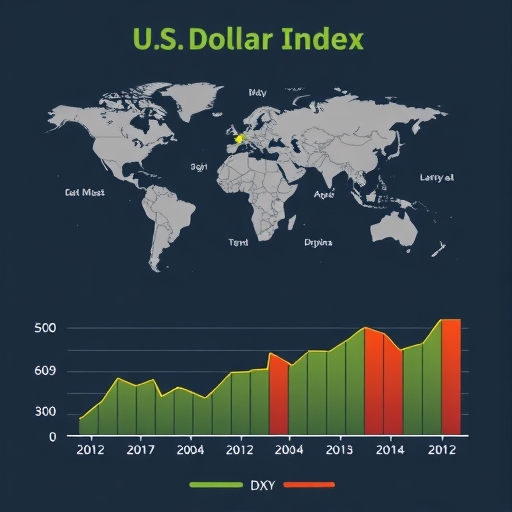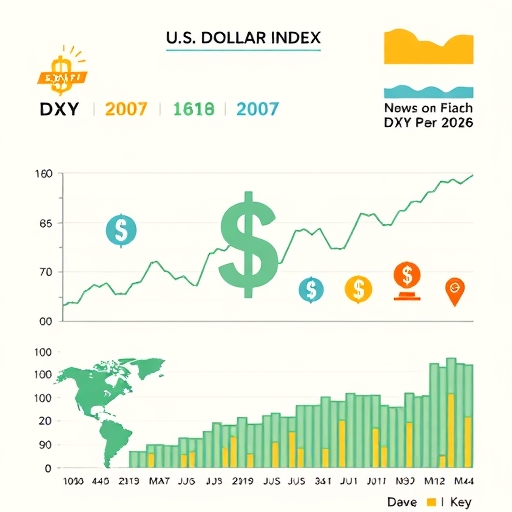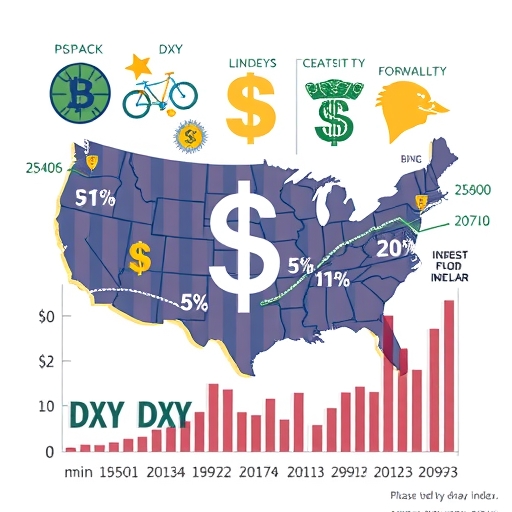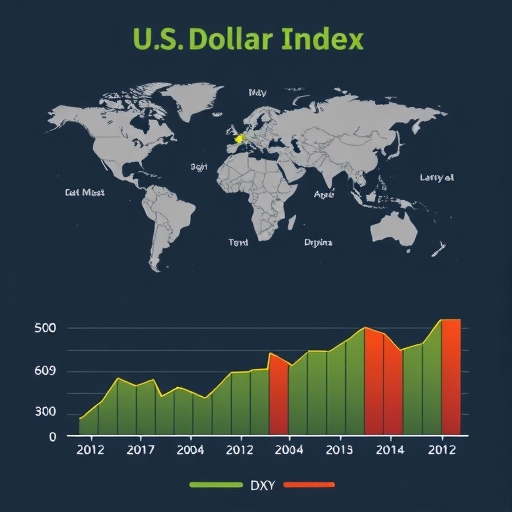Decoding the DXY: The Dollar Index’s Genesis and Its Global Significance
Welcome to an in-depth exploration of one of the most pivotal barometers in global finance: the U.S. Dollar Index (DXY). For any aspiring investor or seasoned trader, understanding the DXY is not merely an academic exercise; it is an essential step towards truly grasping the intricate dynamics of currency markets, commodity prices, and even equity performance. As you embark on this journey with us, we aim to demystify this critical index, transforming complex financial concepts into actionable knowledge.
Have you ever wondered what truly dictates the strength of the world’s reserve currency, the U.S. dollar? The DXY offers a robust answer. Conceived by the U.S. Federal Reserve in 1973, this benchmark was designed to track the performance of the U.S. dollar against a carefully selected group of major global currencies. Think of it as a comprehensive report card for the dollar, reflecting its external bilateral trade-weighted average value. This index provides a singular, digestible figure that encapsulates the dollar’s overall health relative to some of its most significant trading partners.
Why is this important for you? Because the DXY acts as a global economic compass. When the U.S. Dollar Index rises, it signals that the U.S. dollar is strengthening against this basket of currencies. Conversely, a decline in the DXY indicates a weakening dollar. These movements have far-reaching implications, impacting everything from the cost of imported goods to the profitability of multinational corporations, and even the price of precious metals and oil. By the end of this comprehensive guide, you will not only understand what the DXY is but also how its movements can inform your strategic investment decisions.

To truly understand the U.S. Dollar Index (DXY), we must first dissect its fundamental structure: the currency basket and, crucially, the DXY weights assigned to each component. This is where the mathematical heart of the index lies, determining how sensitive the DXY is to fluctuations in any single currency. Imagine a tug-of-war where each participant pulls with a different amount of force; the DXY’s movement is the net result of these weighted pulls.
The DXY is currently calculated using six major global currencies. Each of these currencies is assigned a specific percentage weight, reflecting its relative importance in international trade with the United States at the time of the index’s inception and subsequent adjustments (though the basket itself has remained largely unchanged since the introduction of the Euro). Let’s break down these critical DXY weights:
| Currency | Weight (%) |
|---|---|
| Euro (EUR) | 57.6% |
| Japanese Yen (JPY) | 13.6% |
| Pound Sterling (GBP) | 11.9% |
| Canadian Dollar (CAD) | 9.1% |
| Swedish Krona (SEK) | 4.2% |
| Swiss Franc (CHF) | 3.6% |
Understanding these DXY weights is fundamental. For instance, a 1% depreciation of the Euro against the dollar will have a much larger positive impact on the DXY than a 1% depreciation of the Swiss Franc. This weighting system ensures that the index remains a relevant reflection of the dollar’s value against its most important trading counterparts. When analyzing the DXY, we aren’t just looking at the dollar in isolation; we are observing its performance in a carefully constructed environment designed to provide a comprehensive measure of its strength.

The U.S. Dollar Index (DXY), like any financial instrument, tells a compelling story through its historical performance. From its inception in 1973, the DXY has navigated periods of immense volatility and sustained trends, reflecting the ever-changing tides of global economics and geopolitics. Understanding these past movements provides invaluable context for interpreting its current position and anticipating potential future trajectories. We see the DXY not as a static number, but as a dynamic measure of the U.S. dollar’s constantly evolving value.
Let’s consider some of the DXY’s most significant milestones. The index reached its all-time high of 164.720 USD on February 25, 1985. This period, often associated with the “strong dollar policy” of the Reagan administration and high U.S. interest rates, vividly illustrates how concerted economic policies can dramatically impact currency strength. Conversely, the DXY experienced its lowest ever quote of 70.698 USD on March 17, 2008, amidst the throes of the global financial crisis. This plunge highlighted the dollar’s vulnerability during periods of extreme market stress and the unprecedented monetary easing that followed.
| Milestone | Date | Value (USD) |
|---|---|---|
| All-time High | February 25, 1985 | 164.720 |
| All-time Low | March 17, 2008 | 70.698 |
In more recent times, the DXY has exhibited a dynamic range, oscillating between values approximately from 97.5 to 105.18, reflecting the ongoing market sensitivity to evolving economic narratives and monetary policy shifts. We’ve observed periods of slight gains, such as a recent +0.16% in 24 hours or +0.15% in a single session, indicating short-term strength. However, the DXY has also experienced “steep weekly losses,” underscoring its inherent volatility and responsiveness to breaking news.
Looking at medium-term performance, the DXY has shown modest increases, for example, +0.13% over the last month in some data sets, or +0.39% in others, indicating a slight upward bias during specific periods. However, a broader perspective reveals a more complex picture. Over the long term, we’ve seen figures like -6.40% over the year or -6.51% over the last 12 months in some instances, suggesting a weakening trend over extended periods. Yet, other data points highlight a 1-year increase of 8.76% and a 5-year increase of 8.38%, illustrating that depending on the precise timeframe, the narrative of the U.S. Dollar Index‘s performance can change dramatically. This emphasizes the importance of analyzing the DXY across multiple time horizons to gain a holistic view.

These historical and recent performance figures are not just numbers; they are reflections of underlying economic forces. They serve as a constant reminder that the value of the U.S. dollar is never stagnant, but rather a fluid entity, constantly reacting to a confluence of domestic and international factors. For traders and investors, tracking these movements and understanding their context is paramount to anticipating future shifts in currency strength and adapting their strategies accordingly.
The Federal Reserve’s Unseen Hand: How Monetary Policy Shapes the DXY
If the DXY is the dollar’s report card, then the Federal Reserve (Fed) is undoubtedly the principal. The Fed’s decisions and forward guidance on monetary policy exert a paramount influence over the U.S. Dollar Index. Its actions, particularly concerning interest rates and quantitative easing/tightening, ripple through global financial markets, directly impacting the dollar’s strength and, by extension, the DXY’s trajectory. Have you considered how deeply intertwined the Fed’s dual mandate of maximum employment and price stability is with the dollar’s global standing?
When the Federal Reserve decides to raise interest rates, it makes U.S. dollar-denominated assets, such as U.S. Treasury bonds, more attractive to foreign investors. Why? Because higher yields offer a better return on investment. This increased demand for dollar assets translates into an increased demand for the U.S. dollar itself, causing the currency to strengthen and the DXY to rise. Conversely, when the Fed cuts rates or signals a dovish stance, the dollar tends to weaken, leading to a decline in the DXY. Market expectations for future rate hikes or cuts are often priced into the dollar long before the actual announcements, creating dynamic movements in the index.
| Factor | Impact on DXY |
|---|---|
| Federal Reserve Actions | Directly influences dollar strength |
| Interest Rates | Higher rates strengthen DXY |
| Quantitative Easing/Tightening | Influences dollar availability and strength |
A crucial factor in the Fed’s decision-making process is inflation. Data points such as the Personal Consumption Expenditures (PCE) price index and the Consumer Price Index (CPI) are closely watched. If inflation accelerates significantly, as some recent reports of “alarming reacceleration” have suggested, the Fed might be compelled to adopt a more hawkish stance, potentially raising rates to curb price pressures. Strong inflation data, therefore, often leads to increased rate hike expectations, which in turn can strengthen the U.S. dollar and push the DXY higher. Conversely, cooling inflation could prompt the Fed to consider rate cuts, potentially weakening the dollar.
Beyond explicit rate decisions, the Fed’s commentary and the minutes from its Federal Open Market Committee (FOMC) meetings are meticulously scrutinized by market participants. Every word from Fed Chair Jerome Powell and other officials can send signals about the future direction of monetary policy, shaping market sentiment and influencing the value of the U.S. dollar. Even political pressure on the Fed Chair, such as discussions around potential rate cuts by the end of 2025, becomes a significant factor for market speculation and, consequently, DXY movements. This intricate dance between economic data, central bank rhetoric, and market expectations is what makes tracking the DXY so fascinating and challenging.
Beyond Rates: Navigating the Nuances of Inflation Data and Economic Indicators
While the Federal Reserve’s interest rate decisions form a major pillar of DXY influence, the underlying economic data that informs these decisions is equally critical. To truly anticipate the dollar’s movements, you must look beyond just the headlines and delve into the nuances of specific economic indicators, especially those related to inflation. Understanding this data stream allows us to gain a richer perspective on the dollar’s resilience or vulnerability.
Consider the significance of inflation measures like the PCE Inflation Data. The Personal Consumption Expenditures (PCE) index is the Federal Reserve’s preferred gauge of inflation, and its trajectory heavily influences the Fed’s monetary policy adjustments. If the PCE consistently shows sticky or rising inflation, the market typically anticipates the Fed will maintain a tighter monetary stance, bolstering the U.S. dollar strength and supporting the DXY. Conversely, signs of decelerating inflation could open the door for more dovish policies, potentially leading to dollar weakness.
Beyond inflation, a broader array of economic indicators provides crucial insights into the health of the U.S. economy, which in turn impacts the dollar. For instance, manufacturing and services data, often captured by the S&P Global Purchasing Managers’ Index (PMI) data, offer a timely snapshot of economic activity. Strong PMI readings suggest economic expansion, which can be supportive of the dollar, as it implies a resilient economy capable of handling higher rates. However, mixed PMI data, as we’ve sometimes seen, can make the U.S. dollar struggle to gain traction, leading to currencies like EUR/USD holding steady or GBP/USD remaining defensive.
Furthermore, critical labor market data, such as non-farm payrolls, unemployment rates, and wage growth, also play a significant role. A robust jobs market indicates economic strength and potential inflationary pressures, reinforcing the likelihood of a hawkish Fed and a stronger dollar. Consumer demand indicators, retail sales, and housing data also feed into the overall economic outlook, collectively painting a picture that influences market sentiment and, consequently, currency valuations. It’s a complex mosaic where each piece of data contributes to the dollar’s perceived value and the DXY’s path.
Global Trade and Geopolitics: External Forces Steering the Dollar’s Course
While domestic economic data and Federal Reserve policy form the bedrock of DXY movements, the U.S. Dollar Index operates within a vast, interconnected global economy. Consequently, international trade developments and geopolitical events exert considerable influence, often introducing volatility and shifting the dollar’s role as a safe-haven asset. Have you considered how global alliances and trade agreements might shape your investment outlook?
Trade deals, in particular, can significantly impact global risk appetite and currency valuations. For example, bilateral tariff agreements, such as those forged with Japan or Indonesia, or potential deals with the European Union, can signal reduced trade tensions and increased global economic stability. When trade optimism rises, investors may feel more comfortable moving capital into riskier assets outside the U.S., potentially causing the U.S. dollar to pause or even weaken as its safe-haven appeal diminishes. Conversely, escalating trade disputes can heighten uncertainty, driving investors towards the perceived safety of the dollar, thus boosting the DXY.
Geopolitical events also play a critical role. Major international incidents, like the ongoing impact of Russia’s invasion of Ukraine, create ripples of instability across global financial markets. During such periods of heightened uncertainty, the U.S. dollar traditionally acts as a primary safe-haven currency. Investors flock to dollar-denominated assets, perceiving them as secure amidst global turmoil. This increased demand for the dollar can lead to a rapid surge in the DXY, demonstrating its role as a crisis hedge. However, once the initial shock subsides, or if the U.S. economy itself faces unique vulnerabilities, the dollar’s safe-haven status can be re-evaluated, leading to corrective movements.
The interplay between these global factors and the DXY is dynamic. For instance, the dollar’s strengthening in response to global crises can be a double-edged sword for the U.S. economy, potentially making U.S. exports more expensive and impacting corporate earnings. Therefore, observing how global trade developments and geopolitical shifts unfold is paramount for any investor seeking to gain a comprehensive understanding of the U.S. Dollar Index‘s behavior and its broader implications for the global economy.
The Dollar’s Domino Effect: DXY’s Interplay with Commodities and Equities
The U.S. Dollar Index (DXY) doesn’t exist in a vacuum; its movements create a ripple effect across various asset classes, most notably commodities and equities. Understanding this intricate web of correlations is key to developing a holistic market perspective and optimizing your investment strategy. Have you ever pondered why a strengthening dollar might lead to falling oil prices, or how it influences the profitability of major U.S. companies?
One of the most frequently observed relationships is the inverse correlation between the U.S. dollar strength and commodity prices, particularly gold and oil. Since most major commodities are priced in U.S. dollars on international markets, a stronger dollar makes these commodities more expensive for buyers using other currencies. This effectively reduces demand, putting downward pressure on prices. For example, if the DXY surges due to Federal Reserve tightening cycles, you might often see a corresponding fall in the price of gold, as the dollar becomes a more attractive alternative safe-haven asset, and in the price of oil (WTI), as it becomes pricier for non-dollar buyers. This inverse relationship highlights the dollar’s role as a dominant global currency and its impact on global commodity markets.
The DXY also has a significant, albeit more nuanced, impact on equity markets. For U.S. multinational corporations that derive a substantial portion of their revenue from overseas, a stronger dollar can translate into reduced earnings when foreign profits are converted back into dollars. This is because their foreign sales are worth less in dollar terms. Conversely, a weaker dollar can boost the earnings of these companies. This dynamic is particularly relevant for major indices like the S&P 500, the Dow Jones Industrial Average, and the Nasdaq Composite, which include many globalized companies. Investors often watch the DXY as a proxy for the earnings outlook of these international firms.
Furthermore, changes in the dollar’s value can influence capital flows. A strengthening dollar, often driven by higher U.S. interest rates, can attract foreign investment into U.S. equities and bonds, seeking better returns. This can provide support for the U.S. stock market. However, if the dollar strengthens too rapidly, it could signal economic stress elsewhere or concerns about global growth, which might then negatively impact risk appetite and lead to broader market declines. Therefore, monitoring the U.S. Dollar Index provides critical insights into the underlying currents shaping both commodity and equity markets.
Strategic Engagement: Investing Insights and Tools Related to the DXY
The U.S. Dollar Index (DXY) is a powerful analytical tool, but it’s crucial to understand that it is an index, not a directly investable asset in the same way you might buy a stock. You cannot simply purchase “shares” of the DXY. However, its movements provide valuable insight for investors and traders, and there are indeed several financial instruments that allow you to gain exposure to, or hedge against, the dollar’s strength or weakness. Understanding these options is key to translating DXY analysis into practical investment strategies.
One of the most common ways to directly participate in DXY movements is through DXY futures contracts, traded on exchanges like ICE Futures U.S. These contracts allow you to speculate on the future value of the U.S. Dollar Index. Futures trading is sophisticated and involves leverage, so it’s typically suited for experienced traders who are comfortable with higher risk. It requires a deep understanding of market mechanics and risk management.
For those seeking a more accessible avenue, exchange-traded funds (ETFs) offer a popular alternative. An example is the UUP (Invesco DB US Dollar Index Bullish Fund). This ETF aims to track the performance of the DXY, providing investors with a way to gain long exposure to the U.S. dollar relative to the DXY basket. Conversely, there are also inverse ETFs designed to profit from a weakening dollar. These funds offer diversification and liquidity, making them appealing to a broader range of investors, though it’s important to remember they track the index and may not perfectly replicate its daily movements due to fees and tracking error.
Beyond these direct instruments, investors can strategically invest in the individual currencies that comprise the DXY’s weighted basket. By understanding the DXY weights, you can make informed decisions about pairs like EUR/USD, USD/JPY, or GBP/USD. For instance, if you anticipate a strong dollar against the Euro, you might consider selling EUR/USD. This approach allows for more granular control and enables you to capitalize on specific currency pair movements that contribute to the overall DXY shift.
If you’re looking to explore these currency pairs or delve into the broader world of Contracts for Difference (CFDs) on various financial instruments, choosing the right platform is crucial. If you’re considering beginning your journey in forex trading or exploring a wider range of CFD products, Moneta Markets is a platform worth considering. Originating from Australia, it offers over 1000 financial instruments, catering to both novice and experienced traders alike. Their support for MT4, MT5, and Pro Trader, combined with high-speed execution and competitive spreads, can significantly enhance your trading experience. They also offer multi-country regulatory compliance, including FSCA, ASIC, and FSA, providing a strong sense of security for your investments.
Mastering Market Analysis: Integrating DXY Insights into Your Trading Strategy
Having explored the genesis, composition, and influencing factors of the U.S. Dollar Index (DXY), the next logical step is to understand how to integrate these insights into your active market analysis and trading strategies. The DXY is not just a theoretical concept; it’s a practical tool that can enhance your decision-making across various asset classes. How can you leverage this knowledge to refine your approach and potentially improve your trading outcomes?
First, use the DXY as a primary gauge of overall currency strength for the U.S. dollar. If you are trading a specific currency pair, say EUR/USD, checking the DXY first can provide a macro perspective. A rising DXY implies broad dollar strength, which suggests that even if the Euro has some positive domestic news, it might struggle to gain significant ground against the dollar. Conversely, a falling DXY indicates broad dollar weakness, potentially favoring pairs where the dollar is the counter currency.
Secondly, pay close attention to the DXY in relation to key economic data releases and Federal Reserve announcements. Ahead of major events like inflation reports (PCE, CPI) or FOMC meetings, market participants often position themselves based on expectations. Monitoring the DXY’s reaction during these times can confirm or contradict your initial hypotheses. For example, if inflation data comes in hotter than expected, and the DXY sharply rises, it reinforces the market’s belief in a hawkish Fed and strong dollar, guiding your trades accordingly.
Third, integrate DXY analysis into your commodity and equity trading. As we discussed, there’s often an inverse relationship between the DXY and commodity prices like gold and oil. If you anticipate a significant DXY movement, you can use this insight to inform your directional bias in these markets. Similarly, for equity traders, a strong or weak dollar can influence the earnings prospects of multinational companies, making DXY a useful secondary indicator for sector or individual stock analysis. Remember, these are correlations, not guarantees, but they add layers of insight.
Finally, practice makes perfect. Continuously observe the U.S. Dollar Index chart, relate its movements to headlines, economic reports, and central bank commentary. Over time, you’ll develop an intuitive understanding of its behavior. Utilize technical analysis tools on the DXY chart itself, identifying trends, support and resistance levels, and candlestick patterns, just as you would for any other financial instrument. This disciplined approach to incorporating DXY insights will transform it from a mere number into a powerful ally in your trading arsenal.
The Future Trajectory: What Lies Ahead for the U.S. Dollar Index
As we conclude our comprehensive journey through the multifaceted world of the U.S. Dollar Index (DXY), it’s natural to turn our gaze towards the future. What factors will continue to shape the trajectory of the world’s reserve currency? While predicting precise movements is impossible in the dynamic realm of finance, we can identify the key drivers that will likely dictate the DXY’s path, offering you a framework for ongoing analysis and strategic adaptation.
The primary determinant will undoubtedly remain the Federal Reserve’s monetary policy. The ongoing battle against inflation, coupled with the Fed’s dual mandate, means that every piece of economic data—from jobs reports to consumer spending—will be scrutinized for clues regarding future interest rates. Will the Fed maintain its hawkish stance, or will signs of economic cooling prompt discussions of rate cuts? The market’s pricing of these expectations will continue to be the most significant force behind the DXY’s daily fluctuations. The mere whisper of a policy shift from Jerome Powell can move markets.
Beyond domestic policy, global economic growth differentials will play a crucial role. If the U.S. economy continues to outperform its counterparts in the Eurozone or Japan, the dollar’s relative strength is likely to persist, supporting the DXY. However, a resurgence in growth elsewhere, or a significant downturn in the U.S., could shift the balance. Trade relations and geopolitical stability will also continue to influence risk appetite. New trade deals could foster optimism and potentially weaken the dollar’s safe-haven appeal, while escalating conflicts would likely send investors flocking back to the dollar.
The DXY remains an indispensable tool for investors and analysts, offering critical insights into the dollar’s value. Its intricate calculation, heavily influenced by the specific DXY weights of its constituent currencies, combines with macroeconomic forces like Federal Reserve policy and global trade dynamics to determine its path. As markets continue to digest inflation data and anticipate central bank actions, closely monitoring the DXY provides a vital perspective on the health and direction of the world’s reserve currency, guiding strategic investment decisions in a complex global financial environment.
Ultimately, your success in navigating the markets hinges on continuous learning and adaptation. The DXY is a powerful lens through which to view the interplay of global finance, and by mastering its intricacies, you position yourself to make more informed and strategic decisions. Keep learning, keep observing, and the market’s subtle language will begin to reveal itself to you.
dxy weightsFAQ
Q:What currencies make up the DXY?
A:The DXY is composed of the Euro, Japanese Yen, Pound Sterling, Canadian Dollar, Swedish Krona, and Swiss Franc.
Q:How does the DXY influence commodity prices?
A:A stronger DXY typically leads to lower commodity prices, as commodities are priced in dollars and become more expensive for foreign buyers.
Q:What are DXY futures contracts?
A:DXY futures contracts allow traders to speculate on the future value of the U.S. Dollar Index, providing opportunities for investment based on DXY movements.
